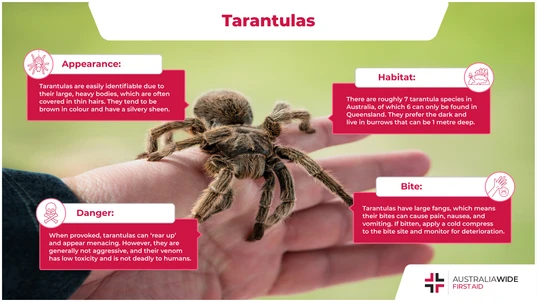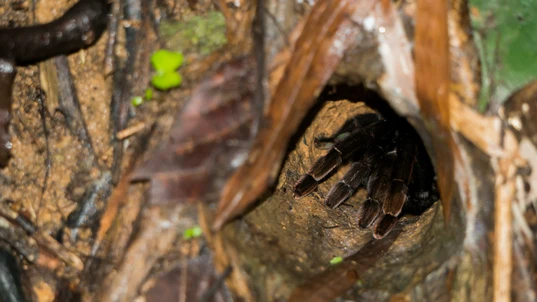Spider Facts: The Tarantula

Bites and Stings

Tarantulas are well-known across the world. Not just because they are widely distributed, but also because they regularly appear on the silver screen. But are tarantulas just as aggressive and deadly as we have been led to believe?
Feared all around the world, tarantulas are a group of rather large and hairy spiders with over 1,000 species having been identified with 156 genera. But despite their terrifying look, these spiders are not as dangerous as the movies make them out to be.All about the Tarantula
Part of the Theraphosidae family, tarantulas are commonly found across the globe, from all over the Americas (i.e. the United States, Central America, and South America) to certain parts of Asia, such as Japan. However, despite the general name ‘tarantula’, there are over 1,000 species of tarantulas with 156 genera. The variety of tarantulas are immense, as each species not only hunt differently, they may also vary in colour and behaviour according to their specific environments. And although they have a reputation as large and hairy killers, tarantulas can be quite shy and would prefer to hide in the darkness rather than attack incoming threats. In Australia, there are roughly 7 species of tarantulas, of which 6 can only be found in Queensland. These tarantulas come from four genera – Selenocosmia, Selenotholus, Selentotypus and Phlogellus – and can be found from Queensland to New South Wales, South Australia, and Western Australia. They are mainly found in rainforests and deserts and can vary in colour from dark-chocolate brown to a pale beige. These spiders have a lifespan of about 12 years and generally live in web-lined burrows in the ground. Tarantulas are also common exotic pets, with an estimated 10,000 tarantulas taken from the wild every year to be sold as pets all across Australia. This is mainly due to their gentle and slow-moving nature. However, the Queensland Government Department of Environment and Science has warned that this may harm local populations and could be threatening the spiders’ survival.Identifying a Tarantula
Tarantulas are easily identifiable due to their large, heavy body that is often covered in thin hairs or fur. Tarantulas generally tend be a certain variant of brown, from reddish brown to pale fawn and even dark brown. Likewise, they often have a silvery sheen to them. Some identifiers that are typical of the tarantula include:- Large, hairy bodies which range in colour from dark brown to pale-reddish brown
- Large fangs approximately 1 cm in length
- Body length approximately 3 – 8 cm in length
- Legs that can span up to 16 cm
- Two pairs of book lungs and three spinnerets
Tarantulas and their hunting habits
Tarantulas are spiders that prefer the darkness and are commonly found in burrows underground. Some tarantulas even hide under rocks and logs to conceal themselves from incoming predators and prey. Generally, these burrows correlate to the size of the spider and can have a depth from anywhere between 40 – 100 cm. These spiders mainly feed at night under the cover of darkness. Tarantulas commonly prey on insects, though they are also known to feed on toads, mice, small frogs, and small snakes. Likewise, they occasionally ambush and eat other large insects like centipedes, millipedes, and other spiders. One of the few natural enemies that tarantulas have are the parasitic pepsis wasp. These wasps can paralyse a tarantula with one sting and lays their eggs on the spider’s body. When they larvae hatch, they will feed off the still-living tarantula. Unlike other spiders, tarantulas don’t use webs to trap their prey. Instead, they spin a trip wire to signal an alert when a small insect happens to approach their burrow. Once this signal reaches the tarantula, it leaps out of its burrow, grabs the prey with its legs, and then uses its fangs to inject the prey with paralysing venom. Tarantulas then secrete a type of digestive enzyme that liquefies the prey’s body and sucks it up through their straw-like mouth openings.Are Tarantulas dangerous to humans?
Contrary to popular belief, tarantulas are not usually aggressive and are of little threat to humans. When provoked, these spiders will ‘rear up’ and can appear rather menacing. However, their venom (while toxic to small insects and other types of prey) has very low toxicity to humans. As such, tarantula bites tend to be harmless and may only result in muscle cramping afterwards.
Tarantulas prefer the darkness and commonly build burrows underground. Instead of spinning webs, tarantulas spin trip wires that signal when a small insect is approaching the burrow, which they then ambush and paralyse.
Tarantula first aid
In saying that, not all tarantulas are harmless. Their fangs are rather large and can be as long as those of snakes. As such, they can inflict painful bites that may result in terrible reactions like nausea, vomiting, skin rashes, or even inflammation of the eyes and nasal passages. These reactions can last from anywhere between six to eight house after the initial bite. When it comes to spider bites, it's always better to be safe than sorry. So, if you get bitten by a tarantula, consult the following first aid procedure:- Reassure the casualty and keep them under constant observation.
- Apply a cold compress to the bite site for periods of up to 20 minutes to lessen the pain.
- If the casualty is a young child (under 8 years), a pregnant woman, or if they exhibit any signs of deterioration, follow the basic life support guidelines per DRSABCD and call Triple Zero (000) for an ambulance.
- DO NOT use the Pressure Immobilisation Technique, as the venom moves slowly and this will just worsen the pain.
Spider bites and anaphylaxis
Spider bites can trigger severe allergy symptoms, including breathing difficulties, facial swelling, and feelings light-headedness. If the casualty begins exhibiting signs of a severe allergic reaction, otherwise known as anaphylaxis, call Triple Zero (000) for an ambulance, consult the Australian Resuscitation Council's anaphylaxis treatment guideline, and follow DRSABCD and prepare to perform CPR.Fun facts about the Tarantula
- The Queensland whistling tarantula, otherwise called the barking spider, is known to be the largest spider in Australia
- Some species of female tarantulas can live up to 30 years, while some species of male tarantulas can live up to 80 years - this makes them one of the longest living spider species
- The name ‘tarantula’ originated from a species of wolf spider native to Mediterranean Europe from the southern Italian town of Taranto
- While most tarantulas are a different shade of brown or beige, the greenbottle blue tarantula is a striking metallic blue with a blue-green carapace
- Female tarantulas can lay up to 3000 eggs
- Discovered in the Northern Territory, an undescribed species of tarantula can swim by coating itself in air bubbles to access their burrows during the wet season
Final thoughts
Tarantulas are one of the most recognised arachnids to ever live. Though they are portrayed on the silver screen as big, hairy killers, they are commonly kept as exotic pets due to their gentle and slow-moving nature. However, like any insect or animal, tarantulas can be unpredictable, and their large fangs can issue painful bites that may trigger a severe allergic reaction. As such, it's important to equip yourself with the skills and knowledge to treat a tarantula bite by attending one of our First Aid courses.Recommended resources
Our Resource Library is brimming with resources on how to identify and treat a wide variety of bites and stings. For instance, we have articles on what to do if you get stung or bitten by a snake, a fire ant, and different types of marine life. Our article on spider bites also does a deep dive on how to identify and treat bites from some of Australia's deadliest spiders, including the Wolf spider, the Huntsman spider, the White tail spider, and the Redback spider. Disclaimer: This article is for informational purposes only. It does not constitute, replace, or qualify as any form of first aid training.
Originally published at
https://www.australiawidefirstaid.com.au/resources/tarantula
as part of the Australia Wide First Aid Articles Library









